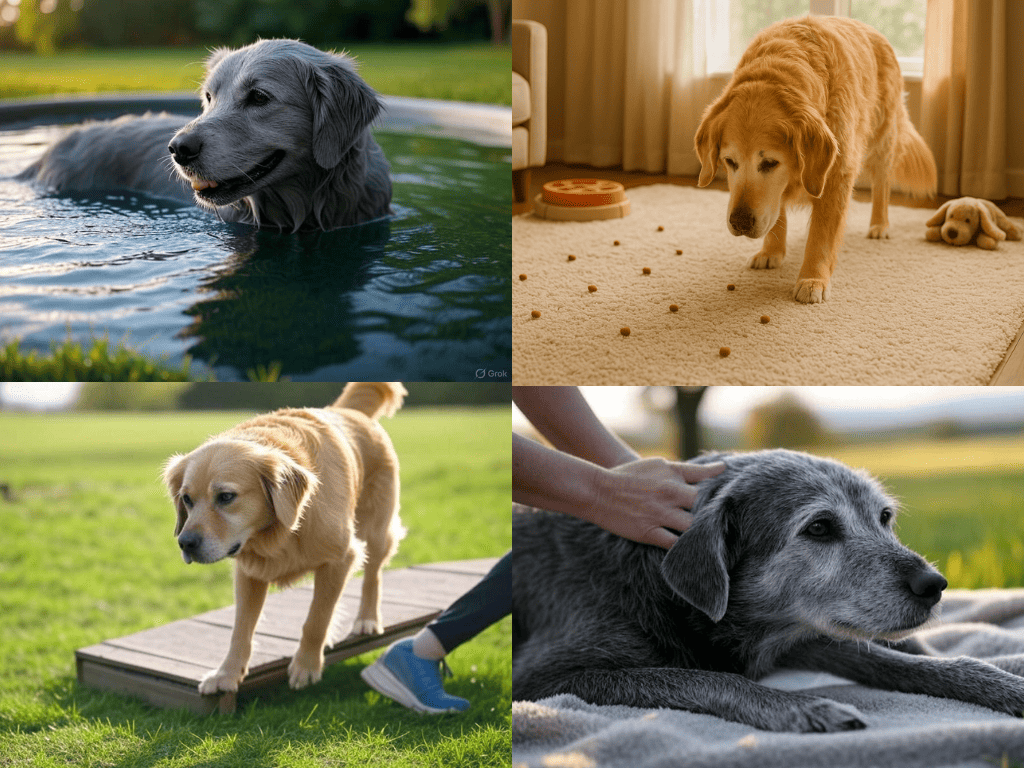Help your senior dog move better and feel more comfortable with these gentle, effective exercises.
Meta description:
Discover 5 simple and safe exercises to improve flexibility in senior dogs with arthritis. Enhance their mobility, reduce joint pain, and boost their quality of life.
How Arthritis Affects a Dog’s Flexibility
Arthritis is a common condition in older dogs that affects the joints, causing inflammation, stiffness, and pain. As dogs age, the cartilage that cushions their joints wears down, leading to bone-on-bone contact. This results in discomfort and reduced mobility, especially in weight-bearing joints like the hips, knees, and elbows.
Typical symptoms of arthritis in senior dogs include difficulty standing up or lying down, reluctance to climb stairs, limping, or avoiding physical activity altogether. Over time, the loss of flexibility can severely impact your dog’s ability to move and perform everyday tasks.
Maintaining joint flexibility is essential for easing stiffness and improving overall mobility. Gentle and regular exercise can help support the joints, strengthen surrounding muscles, and enhance circulation, making movement more comfortable for your dog.
1. Short and Gentle Walks
Short walks are one of the best ways to keep your arthritic senior dog flexible. They increase blood flow and promote natural joint lubrication, which helps reduce stiffness and discomfort.
Tips:
- Keep the walks short and take frequent breaks.
- Walk on soft, non-slip surfaces like grass or carpet to minimize impact on joints.
- Avoid steep hills or stairs.
- Watch for signs of fatigue or pain, and adjust the duration as needed.
These walks not only improve physical flexibility but also provide mental stimulation and bonding time with your dog.
2. Guided Stretching
Gentle stretching helps reduce muscle tension and improves range of motion in dogs with arthritis. It’s a great way to keep joints flexible and ease stiffness.
Benefits:
- Increases blood circulation in key areas.
- Helps maintain muscle and tendon elasticity.
- Reduces joint pain over time.
Stretching examples:
- Rear leg stretch: Gently support your dog’s hind leg and slowly extend it backward. Hold for a few seconds, then release.
- Neck stretch: Use a treat to guide your dog’s head up, down, and side to side to stretch the neck gently.
Tips:
- Be very gentle and never force a stretch.
- Watch your dog’s reaction and stop if they show signs of discomfort.
- Daily stretches can become part of a calming routine that promotes mobility and connection.
3. Supervised Swimming
Swimming is a low-impact exercise ideal for senior dogs with arthritis. Water supports your dog’s body weight, allowing them to move freely and safely.
Benefits:
- Enhances joint flexibility without pressure.
- Strengthens muscles around the joints.
- Improves circulation and reduces stiffness.
Tips:
- Start slow, especially if your dog is new to water.
- Always supervise and use a dog life vest if needed.
- Choose warm water when possible to relax the muscles.
Regular swim sessions can help your dog stay active and comfortable with less joint strain compared to land exercises.
4. Low Obstacle Courses
Gentle obstacle courses can be fun and therapeutic. They encourage controlled movement and improve coordination, which supports flexibility.
Benefits:
- Encourages natural joint movement.
- Strengthens supporting muscles.
- Keeps your dog mentally stimulated and physically engaged.
Tips:
- Use soft, low obstacles like pillows, cones, or cushions.
- Guide your dog slowly through the course using treats or toys.
- Change the layout to keep it interesting and target different movements.
Always adapt the setup based on your dog’s ability, and avoid fast or high-impact motions.
5. Therapeutic Massage
Massage is an excellent tool to reduce muscle tightness and improve circulation, both of which contribute to better joint flexibility.
Benefits:
- Relieves stiffness and muscle tension.
- Increases blood flow to painful areas.
- Provides relaxation and emotional comfort.
Tips:
- Use light, circular motions with your fingertips on areas like shoulders, back, and thighs.
- Avoid applying strong pressure, especially near sore joints.
- Watch your dog’s reactions—massage should be a pleasant experience.
Massage works well after exercise when the muscles are already warm and can be part of a weekly wellness routine.
Safety Tips for Exercising Dogs with Arthritis
To ensure your dog’s safety and comfort during exercises, keep these precautions in mind:
- Watch for signs of fatigue or pain: Panting, limping, or lying down suddenly are signs to stop.
- Create a safe environment: Use soft, non-slip surfaces and avoid stairs or slippery floors.
- Adjust exercises as needed: As arthritis progresses, your dog’s needs will change. Always consult your veterinarian to make sure the exercise routine remains safe and appropriate.
Conclusion
Supporting your senior dog’s flexibility through gentle exercises can significantly enhance their mobility and quality of life. The five exercises outlined—short walks, guided stretching, supervised swimming, low obstacle courses, and therapeutic massage—are practical ways to reduce stiffness and improve joint health.
Every dog is unique, so take the time to learn your dog’s limits and adjust the routine accordingly. With patience, care, and veterinary guidance, you can help your aging dog stay active, comfortable, and happy for years to come.

